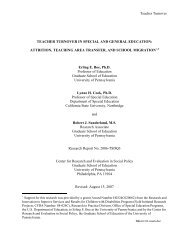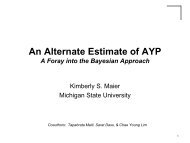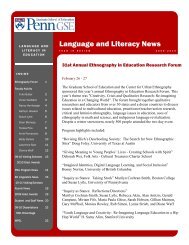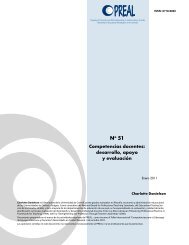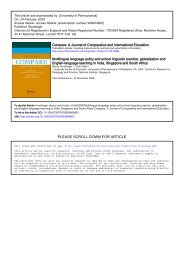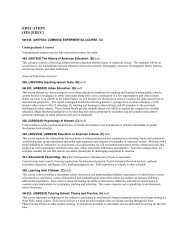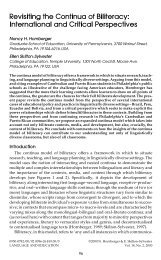does teacher preparation matter for beginning teachers in
does teacher preparation matter for beginning teachers in
does teacher preparation matter for beginning teachers in
You also want an ePaper? Increase the reach of your titles
YUMPU automatically turns print PDFs into web optimized ePapers that Google loves.
<strong>teacher</strong>s (Lank<strong>for</strong>d, Loeb, & Wyckoff, 2002). These results support the general conclusion that<br />
the more students are at risk of failure, the less well prepared are the <strong>beg<strong>in</strong>n<strong>in</strong>g</strong> <strong>teacher</strong>s hired to<br />
teach them.<br />
Teachers’ Union Membership. With respect to union membership, <strong>beg<strong>in</strong>n<strong>in</strong>g</strong> SETs and<br />
GETs with extensive <strong>preparation</strong> were more likely than other <strong>beg<strong>in</strong>n<strong>in</strong>g</strong> <strong>teacher</strong>s to secure teach<strong>in</strong>g<br />
positions <strong>in</strong> unionized schools (see Table 2). Union data <strong>in</strong>dicate that such schools provide<br />
somewhat higher salaries and more achiev<strong>in</strong>g students (as measured by higher SAT scores) (Nelson<br />
& Drown, 2003). Teachers generally prefer such schools.<br />
Regular vs. Charter Public Schools. As also seen <strong>in</strong> Table 2, a very small percentage of <strong>beg<strong>in</strong>n<strong>in</strong>g</strong><br />
SETs and GETs were hired by charter schools (0.5% vs. 1.3%, respectively). Even though<br />
these percentages are small, they show that charter schools had proportionately fewer <strong>beg<strong>in</strong>n<strong>in</strong>g</strong><br />
SETs than GETs.<br />
Full- vs. Part-Time Employment. F<strong>in</strong>ally, extensive <strong>teacher</strong> <strong>preparation</strong> did not give <strong>beg<strong>in</strong>n<strong>in</strong>g</strong><br />
SETs an advantage over those with only some <strong>preparation</strong>, or unprepared, SETs <strong>in</strong> secur<strong>in</strong>g<br />
full-time/regular teach<strong>in</strong>g positions (see Table 2). In contrast, complet<strong>in</strong>g extensive <strong>teacher</strong><br />
<strong>preparation</strong> did give <strong>beg<strong>in</strong>n<strong>in</strong>g</strong> GETs a slight advantage <strong>in</strong> secur<strong>in</strong>g full-time/regular teach<strong>in</strong>g<br />
positions.<br />
Overall, the results shown <strong>in</strong> Table 2 demonstrate that complet<strong>in</strong>g extensive <strong>teacher</strong> <strong>preparation</strong><br />
<strong>matter</strong>s considerably <strong>in</strong> hir<strong>in</strong>g <strong>beg<strong>in</strong>n<strong>in</strong>g</strong> SETs and GETs <strong>in</strong>to schools <strong>in</strong> which <strong>teacher</strong>s prefer<br />
to practice. Further, these results show that <strong>beg<strong>in</strong>n<strong>in</strong>g</strong> <strong>teacher</strong>s who complete only some<br />
<strong>preparation</strong> are not only disadvantaged <strong>in</strong> this respect, but they ga<strong>in</strong> little or no advantage over<br />
<strong>beg<strong>in</strong>n<strong>in</strong>g</strong> <strong>teacher</strong>s without any <strong>teacher</strong> <strong>preparation</strong>.<br />
Do Teacher Reports of Be<strong>in</strong>g Well Prepared to Teach Vary by Amount of Teacher Preparation?<br />
Figure 2 shows the percentages of <strong>beg<strong>in</strong>n<strong>in</strong>g</strong> SETs <strong>in</strong> public schools who reported be<strong>in</strong>g<br />
well prepared <strong>in</strong> each of seven capabilities accord<strong>in</strong>g to amount of <strong>preparation</strong> <strong>in</strong> pedagogy and<br />
supervised teach<strong>in</strong>g. Exclud<strong>in</strong>g the seventh capability listed (to use computers <strong>in</strong> education) <strong>for</strong><br />
which differences among amounts of <strong>teacher</strong> <strong>preparation</strong> were not statistically significant, SETs<br />
with extensive <strong>preparation</strong> reported be<strong>in</strong>g “better prepared” than SETs with only some <strong>preparation</strong><br />
<strong>in</strong> each of the other six teach<strong>in</strong>g capabilities. As might be expected, SETs without any<br />
<strong>preparation</strong> reported be<strong>in</strong>g the least well prepared (except <strong>for</strong> small differences <strong>in</strong> assess<strong>in</strong>g students<br />
and handl<strong>in</strong>g classroom management).<br />
15



